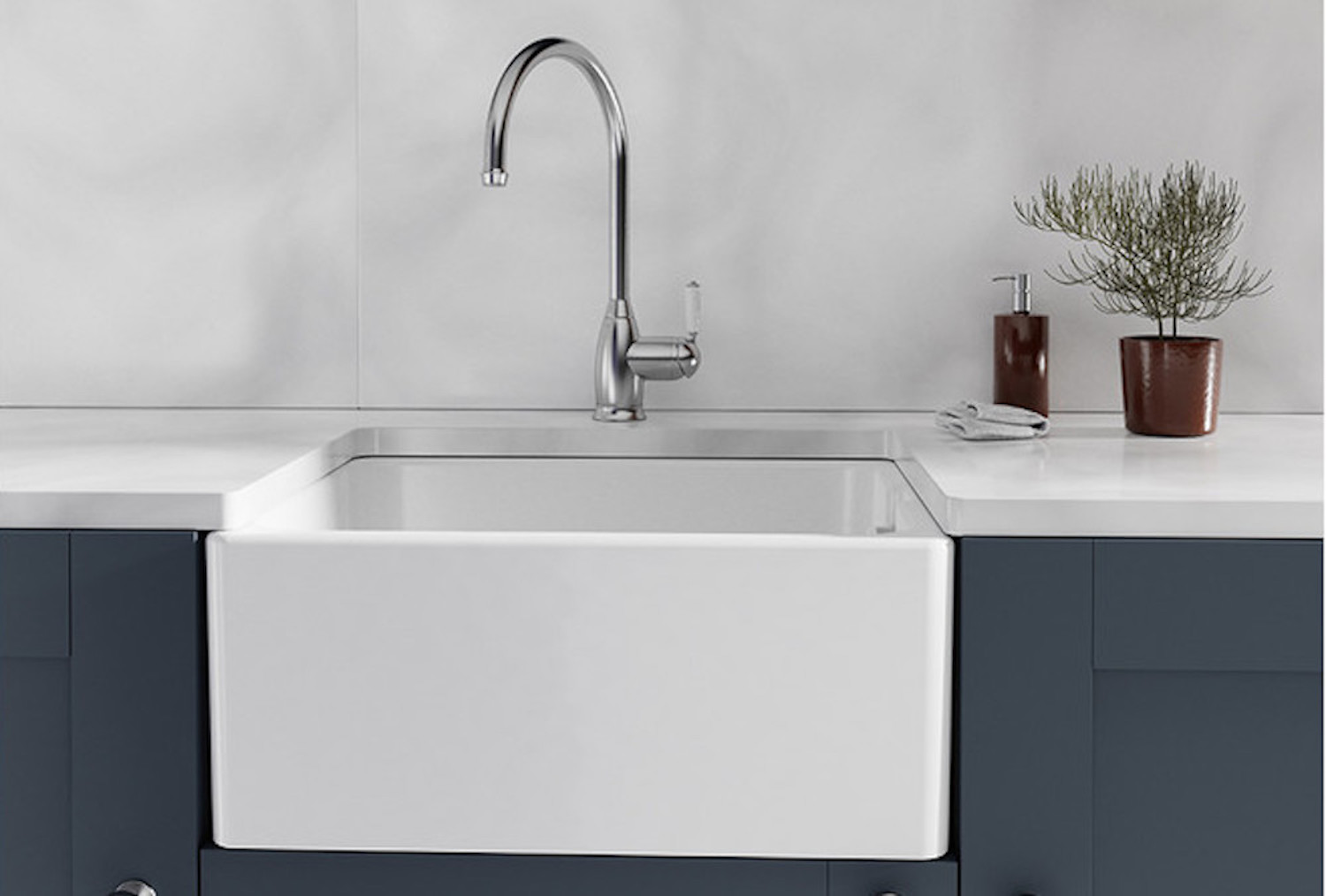What Is A Belfast Sink?

Deeply steeped in history and traditional British design, the Belfast sink serves as a statement piece in a kitchen.
Beyond just being a functional item, it carries a story and a unique aesthetic.
So, what makes a Belfast sink special?
Let's explore this classic kitchen feature in more detail.
What Is A Belfast Sink?
A Belfast sink, also known as a butler sink, is a traditional style of sink originating in the UK.
It's a large, deep, rectangular ceramic sink, typically made from fireclay.
Its design was originally used in the late 17th century for butlers to clean large pots and pans that wouldn't fit in standard sinks.
A distinctive feature of a Belfast sink is its overflow outlet, which allows excess water to be drained away to prevent spills, a design aspect originating from Belfast where water supply was abundant.
Today, Belfast sinks are popular for adding a touch of classic charm to both traditional and contemporary kitchens due to their timeless and functional design.
What Are Traditional Belfast Sinks Made Of?
Traditional Belfast sinks are made from fireclay, a particular type of ceramic material that is very durable.
Fireclay is formed when clay is glazed and then heated to extremely high temperatures, creating a hard, smooth surface that is resistant to scratches, staining, and chipping.
This process also makes the sink very heat resistant.
The typical colour for a Belfast sink is white, though it can come in other colours.
This combination of resilience and aesthetics contributes to the enduring popularity of the Belfast sink in kitchens.
Why Is It Called A Belfast Sink?
The name "Belfast Sink" originates from the city of Belfast in Northern Ireland.
Historically, the design of the sink reflected the fact that in Belfast, there was no restriction on water usage, so the sinks were made large and deep to hold plenty of water.
This is in contrast to another similar type of sink known as the "Butler Sink."
While both types are similar, the Butler Sink, which originated in London, was designed with a shallower basin due to limitations on water usage in that area.
Over time, these types of sinks became associated with their respective cities, hence the names "Belfast Sink" and "Butler Sink."
What Are the Advantages of Belfast Sinks?
Belfast sinks come with a variety of advantages that make them a popular choice for many homeowners. Here are a few of the key benefits:
- Durability: Belfast sinks are typically made from fireclay ceramic, which is extremely durable and resistant to chipping, scratching and staining.
- Large Capacity: Their large, deep design makes them ideal for washing large pots and pans or for soaking laundry.
- Aesthetically Pleasing: With their traditional design, Belfast sinks can add a timeless, classic touch to any kitchen, especially those with a rustic or farmhouse-style decor.
- Hygienic: The glazed surface of the ceramic is easy to clean and does not promote bacterial growth.
- Heat Resistant: Ceramic sinks resist heat, so hot pans or boiling water will not damage the surface.
- Versatile: Despite their traditional aesthetic, Belfast sinks can also fit well in more contemporary styled kitchens depending on the design and fittings used around them.
Remember that the placement, plumbing and surrounding fixtures of the sink need to accommodate its size and weight, so proper installation is crucial.
What Are the Disadvantages of Belfast Sinks?
While Belfast sinks are undoubtedly charming and functional, they do have a few disadvantages that you should consider:
- Size and Weight: Belfast sinks are typically heavy and large, which might require reinforced cabinetry for support. They also take up a lot of space, which might not be suitable for smaller kitchens.
- Difficulty in Installation: Due to their size and weight, Belfast sinks can be difficult and expensive to install. They are usually installed under the countertop, which can require additional work and expertise.
- Cost: Belfast sinks are often more expensive than other sink types. The cost not only includes the sink itself but also the potential extra expense of installation.
- Potential for Damage: While Belfast sinks are generally quite durable, they can chip or crack if heavy objects are dropped into them. Moreover, they can cause damage to glassware or crockery if these items are dropped into the sink due to its hard surface.
- Staining: While they are resistant to many forms of staining, certain substances like tea, coffee or red wine can cause stains on the white ceramic if not cleaned up promptly.
- Lack of Draining Board: Traditional Belfast sinks do not come with a built-in draining board, although this can be mitigated with a standalone board or by choosing a sink with an integrated drainer.
Before purchasing a Belfast sink, it's essential to weigh these potential drawbacks against the benefits to make the right choice for your home and lifestyle.
Belfast Sink Maintenance
Maintaining a Belfast sink is relatively straightforward.
Their smooth, glazed surface allows for easy cleaning with mild, non-abrasive cleaners.
It's essential to avoid harsh chemicals that may damage the glaze.
For stubborn stains, baking soda mixed with water can serve as an effective cleaning paste.
Preventing chips and scratches is crucial – avoid dropping heavy objects and consider using a sink protector or a plastic basin.
Choosing the Right Belfast Sink
When choosing a Belfast sink, consider the size of your kitchen and the sink's purpose.
Measure your available space to ensure a good fit.
Think about whether a single or double bowl would be more beneficial for your usage.
Consider the style and colour of the sink, ensuring it matches your kitchen's aesthetic. Lastly, quality is vital.
Make sure to choose a reputable manufacturer for a durable and long-lasting sink.
Comparing Belfast Sinks with Other Sink Types
When compared to other sink types, Belfast sinks stand out with their deep, wide dimensions and distinctive aesthetics.
For example, stainless steel sinks, while durable and more affordable, don't offer the same classic charm.
Composite granite sinks can match the Belfast sink in terms of durability and visual appeal but lack the unique history and character.
Undermount sinks provide a sleek look and easy countertop cleaning, but they lack the standout presence of a Belfast sink.
Belfast Sinks and Sustainability
The sustainability of Belfast sinks comes into focus when you consider their robustness and durability.
These sinks, traditionally made from high-quality ceramic, are known for their resilience.
Withstanding heat and everyday wear and tear, they don't require frequent replacements, which contributes to reducing landfill waste.
By choosing a Belfast sink, you're opting for a product that could serve you for decades, thereby diminishing the environmental impact associated with the production of new sinks.
Therefore, even though ceramic production does consume energy, the long lifespan of a Belfast sink can justify this initial environmental cost.
However, sustainability is a multi-faceted concept, so it's also important to consider the manufacturing practices of the brand from which you buy your Belfast sink.
Tips From an Expert Kitchen Fitter
Over the years, I have sold and installed hundreds of Belfast sinks both old and new).
For more traditional-looking kitchens, I think they can look really great.
However, some people find that they aren't always the best sinks for washing up in, and they much prefer a more shallow standard style of kitchen sink.
Final Notes On Belfast Sinks
Embodying a piece of British heritage, a Belfast sink is more than just a functional kitchen feature.
It's a statement of style, a nod to history, and a practical addition to your home.
Despite certain drawbacks, its many advantages, including durability, aesthetics, and sustainability, make it a worthwhile consideration for your kitchen.

